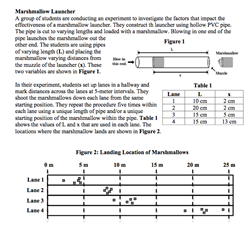 Marshmallow Launcher
Marshmallow Launcher
Resource:
Science Reasoning Center: Marshmallow Launcher
Grade Level: High School
Description:
This passage describes an experiment in which students alter and test variables that impact the effectiveness of a marshmallow launcher. Data is provided in the form of a table and two diagrams. Questions target a student's ability to identify the effect of changes in a variable upon an outcome, to identify dependent and independent variables, to interpolate and extrapolate from provided data, to understand the design of an experiment, to draw conclusions that are consistent with the provided data, and to extend the findings of an experiment to a new situation.
This activity aligns with the three dimensions of the Next Generation Science Standards in the manner described below:
| Forces and Motion (HS-PS2.A.3): If a system interacts with objects outside itself, the total momentum of the system can change; however, any such change is balanced by changes in the momentum of objects outside the system. |
In this experiment, an impulse is delivered to a marshmallow as a student blows into a long pipe containing the marshmallow. As the readers analyze the given data, they find that the marshmallow’s distance traveled varies with different lengths of pipe and different marshmallow starting locations within the pipe. The student will see that the larger the impulse given to the marshmallow the greater its change in momentum and the great the distance it will travel. |
| Cause and Effect: Systems can be designed to cause a desired effect. |
A cause and effect relationship is explored as the student analyzes how changing pipe length and marshmallow starting location affect the distance a marshmallow will be launched. Questions at the end of the passage require the learner to reason through the cause of some marshmallows traveling further than others. |
| Patterns: Empirical evidence is needed to identify patterns. |
Students consider the distance a launched marshmallow travels for a given pipe length and initial position within the pipe. As the results are displayed pictorially in various “launch lanes,” the experimenter begins to see patterns within the data that lead one to determine how changing these variables affects launch distance. |
| Planning and Carrying out Investigations: Make directional hypotheses that specify what happens to a dependent variable when an independent variable is manipulated. |
Questions 3, 4, 5, and 11 at the end of this passage probe the student’s ability to both understand experimental design vocabulary (independent and dependent variable) as well as why only one variable is changed at a time. In doing so, the student is making a hypothesis as to what happens when the independent variable is changed. |
| Analyzing and Interpreting Data: Analyze data in order to make valid and reliable scientific claims or determine an optimal design solution. |
While reading a data table or diagram is a critical skill for all scientists, being able to combine information from one data presentation with that from another is a higher level skill. Questions 1, 2, and 9 require students to both analyze individual data presentations as well as combine data from multiple data representations to make a scientific claim and determine the optimal conditions to maximize a marshmallow’s range. |
| Developing and Using Models: Develop a model based on evidence to illustrate the relationships between systems or between components of a system. |
Question 10 from this passage asks the student to identify which model best supports the data collected. Students must use data from two of the trials to identify the conclusion that is best supported by the trials. |
| Constructing Explanations and Designing Solutions: Apply scientific reasoning to link evidence to the claims to assess the extent to which the reasoning and data support the explanation or conclusion. |
The product of scientific investigation is an explanation; the product of an engineering endeavor is a solution. Questions 6, 7, and 8 from this passage require students to both construct explanations as well as design a scenario which will maximize the range of a marshmallow. |
Associated Reading from The Physics Classroom
Other Supporting Pages at The Physics Classroom:
View Infographic.
(Coming Soon)
Search the NGSS Corner
Maybe you're looking for something really specific that pertains to a desired topic and emphasizes one or more of the listed NGSS dimensions. Why not try a search of this section of our website? Simply select from one or more of the pull-down menus and click Search This page will reload and a collection of possibilities will be displayed in this section of the page and sorted by relevancy.